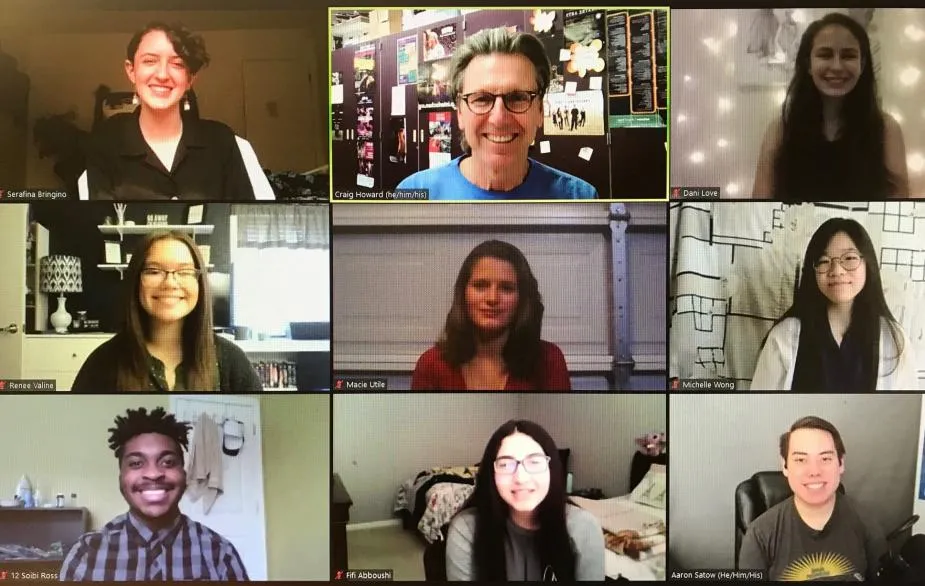Federal judges and court staff conducted a variety of public outreach and communications efforts to improve public understanding of the Judiciary’s role in American democracy.
Communications Support During the Pandemic

U.S. Magistrate Judge Patricia Morris, wearing a face shield, administers the Oath of Allegiance during a drive-through naturalization ceremony in Detroit.
Beginning in March, the Judiciary’s communications needs increased substantially amid the COVID-19 pandemic. Several efforts were undertaken to bolster both internal and external communications, making use of multiple channels including websites, email subscription services, video messaging, and timely media outreach. The Administrative Office of the U.S. Courts (AO) kept the media and the public up to date on the status of court operations and proceedings systemwide and explained the use of teleconferencing, videoconferencing, and other methods quickly being adopted to maintain remote public access to court proceedings.
Another focus was providing information to the public about the protocols put in place by the federal courts to keep jurors and other participants safe as trials, grand juries, and court hearings resumed in some courthouses. The AO assisted several courts with creating public-service messages consisting of short videos of federal judges describing their courts’ protocols, which were posted on court websites.
The AO also set up a robust system of communication among the courts to share vital information internally, such as recovery guidelines and checklists designed to help courts evaluate when it was safe to restore some courthouse operations.
A COVID-19 guidance clearinghouse was set up on JNet, the Judiciary’s intranet. The resource allowed the AO and the courts to share more than 100 guidance memos and response and recovery documents, 1,500 links to pandemic-related court orders around the country, answers to frequently asked questions, and four dashboards displaying data about COVID-19’s impact on Judiciary operations. The resources amassed nearly 350,000 pageviews by Judiciary users by mid-November 2020.
Civics Education
Courts were increasingly involved in civics education programs in 2020 following Supreme Court Chief Justice John Roberts, Jr.’s call for a renewed emphasis on civics outreach in his 2019 Year-End Report on the Judiciary. At its March 2020 meeting, the Judicial Conference affirmed that civics education is an important component of judicial service. It endorsed regularly scheduled conferences to share and promote best practices in civics education, and it encouraged circuits to coordinate and promote civics programs.
During the pandemic, the AO launched a national distance learning initiative to bring judges and court literacy basics into schools and homes. The programs emphasized the federal courts’ commitment to adhering to the rule of law without fear or favor regardless of personal beliefs, public opinion, or perceived political pressures.
Online resources were made available to social studies teachers to help them stimulate critical thinking and thoughtful discussions in virtual classrooms. Virtual activities, presented in different formats and time lengths, addressed the impact on teens of the rule of law, separation of powers, judicial independence, and jury service by relating these concepts to their daily lives. Civil discourse and smart decision-making were emphasized in all the programs.
Federal judges also created online civics opportunities to help students observe Constitution Day and Citizenship Day on Sept. 17, despite the suspension of courthouse trips and classroom visits during the pandemic. One example was the Second Circuit’s Justice for All: Courts and the Community programs. In recent years, the Judiciary has called attention to the Constitution and to citizenship by hosting naturalizations and other community events.

High school students and their theater teacher in Sacramento, California engage in an interpretive reading of the Preamble during a virtual Constitution Day and Citizenship Day event hosted by the federal courts.
The Judiciary held its first-ever National Conference on Civic Education and the Federal Courts in late 2019. A 26-page report released in 2020 summarized observations and insights gained at the conference, which brought together 138 judges, Judiciary employees from across the country, and representatives from civics organizations to share best practices, innovative programs, and resources aimed at improving the public’s understanding of the Third Branch of government.
Judiciary Provides History Lessons
The Judiciary continued its video-based civics outreach with a new installment in the Moments in History series, which showcases cases and people that have shaped the nation and the courts. The video tells the remarkable story of Chief Standing Bear, who in 1879 persuaded a federal judge that he and his fellow Ponca were citizens entitled to the same constitutional rights as other U.S. citizens. The case established him as one of the nation’s earliest civil rights heroes. The video was released in October in anticipation of Native American Heritage Month in November.
To mark the observance of Pride Month in June, the AO hosted a videoconference with five openly LGBTQ judges from different backgrounds and experiences to offer insight into their lives. In honor of African American History Month in February, the AO published a story recounting the life of Constance Baker Motley, an African American judge who played a pivotal role in the fight to end racial segregation from the 1940s to the 1960s, putting her own safety at risk in many instances.
Improved PACER Website
The AO redesigned the website used by the public to access the Judiciary’s electronic court records system, known as PACER (Public Access to Court Electronic Records). The upgraded PACER website includes features making it easier for users to learn how to navigate the system, to find what they are looking for more quickly, and to understand the fee structure for downloading records. The improvements added modern navigation tools with graphical aids, easy-to-grasp instructions for registering for a PACER account, and mobile-friendly design for use with smartphones and other mobile devices. The upgrade also was designed to improve accessibility for all users, including people with disabilities. The project was undertaken in response to feedback from users and as part of the Judiciary’s ongoing effort to improve public access.
PACER Public User Group
Twelve people from diverse backgrounds in the law, media, government, and academia were selected in early 2020 to serve on a new public user group to provide advice and feedback on ways to improve PACER and other Judiciary electronic public access services. The group held its inaugural meeting in February and met two additional times during the year. The members were selected based on user type, level of experience using PACER, frequency of usage, an account status in good standing, and a commitment to collecting additional feedback from their peers. The group discussed PACER and other Judiciary electronic public access services from the user’s perspective with the goal of recommending improvements and expansion. Meeting agendas, minutes, and other relevant information were made available online.
Annual Report 2020
- Annual Report 2020
- Court Operations and Pandemic Response
- Funding/Budget
- The Courts and Congress
- The Federal Bench
- Accountability and Resource Management
- Facilities and Security
- Public Outreach
- Defender Services
- Probation and Pretrial Services
- Human Resources
- Information Systems and Cybersecurity
- Recent and Proposed Amendments to Federal Rules
- In Profile
